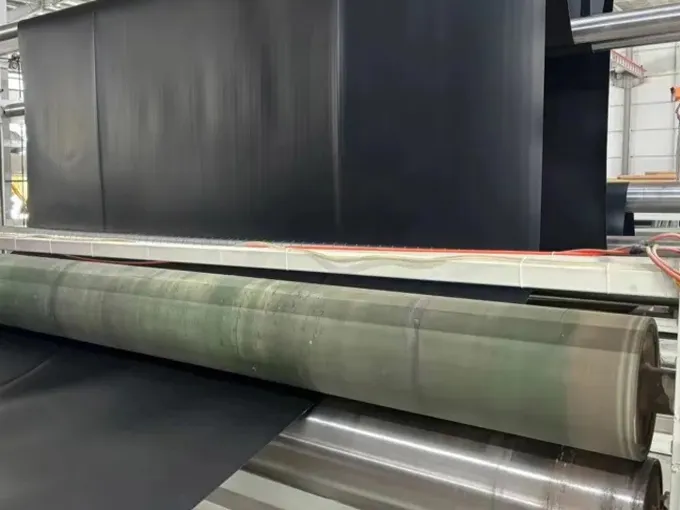When it comes to reservoir construction, selecting the right geomembrane for anti-seepage is crucial to ensure long-term durability, environmental safety, and cost-effectiveness. Geomembranes are impermeable membranes used widely in water containment projects, including reservoirs, to prevent leakage and protect water resources. This guide will walk you through the key factors to consider when choosing the best geomembrane for your reservoir project, ensuring optimal performance and compliance with industry standards.

Key Factors to Consider When Choosing a Anti-seepage Geomembrane for Water Storage Tank
1. Material Selection
Common Materials: High-density polyethylene (HDPE), linear low-density polyethylene (LLDPE), and polyvinyl chloride (PVC) are the most commonly used materials for geomembranes.
HDPE Geomembrane: The most widely used material due to its excellent anti-seepage properties, chemical resistance, and long service life.
LLDPE Geomembrane: Offers greater flexibility and is suitable for projects requiring adaptability to uneven surfaces.
PVC Geomembrane: Known for its ease of installation and flexibility, but less durable compared to HDPE.
2. Thickness
Bottom Liner: Typically ranges from 0.5 mm to 2 mm, depending on the reservoir's design and water pressure.
Sidewalls: Thickness should be determined based on specific design requirements and geological conditions to ensure stability and durability.
3. Installation and Seaming
Continuous Coverage: The geomembrane must be laid continuously across the reservoir's bottom and sidewalls to ensure full coverage.
Seaming Methods: Use heat fusion welding or extrusion welding to join geomembrane panels, ensuring a watertight seal.
Edge Treatment: Edges should be wide enough for secure anchoring and reinforcement. Common methods include burying in soil, covering with concrete, or using edge reinforcement structures.
4. Inspection and Repair
Post-Installation Inspection: Conduct thorough inspections after installation to ensure the geomembrane's integrity.
Repairing Leaks: Any punctures or leaks should be repaired immediately using patches or welding techniques to maintain the anti-seepage performance.
5. Auxiliary Materials
Anti-Seepage Layers: Use additional layers like geotextiles or protective mats to enhance stability and reliability.
Anchoring Systems: Secure the geomembrane with anchors or ballast to prevent movement or damage.
Advantages of Using Anti-seepage Geomembranes for Water Storage Tank
Superior Anti-Seepage Performance: Reduces water leakage by 90%–95%, ensuring efficient water storage.
Lightweight and Easy to Transport: Reduces transportation costs and simplifies handling.
High Flexibility: Adapts to ground deformations and uneven surfaces.
Quick Installation: Simplifies construction and shortens project timelines.
Chemical Resistance: Withstands exposure to harsh chemicals and environmental conditions.
Cost-Effective: Lower initial and maintenance costs compared to traditional methods.
Types of Geomembranes
1. By Base Material
Non-Woven Composite Geomembranes: Includes short-fiber needle-punched and filament-bonded types.
2. By Membrane Material
Polyethylene (PE): Includes HDPE and LLDPE.
Polyvinyl Chloride (PVC): Flexible and easy to install.
Chlorinated Polyethylene (CPE): Offers enhanced chemical resistance.
3. By Structure
One Fabric, One Membrane (1F1M): Combines one layer of fabric with one layer of membrane.
Two Fabrics, One Membrane (2F1M): Provides additional strength and durability.
Multi-Layer Structures: Suitable for high-stress applications.
Construction Best Practices
Follow Technical Specifications: Adhere to industry standards during preparation, installation, seaming, inspection, and backfilling.
Avoid Over-Tightening: Ensure the geomembrane is laid without wrinkles or excessive tension.
Reinforce Seams: Use strong welding techniques to prevent seam failure.
Choose the Right Composite: For most reservoir projects, a 2F1M composite geomembrane is recommended due to its high tear resistance, aging resistance, and adaptability to temperature variations.
Environmental Considerations
Eco-Friendly Options: Virgin geomembranes are more environmentally friendly, making them suitable for projects with high environmental and water quality standards.
Sustainability: Choose recyclable materials to minimize environmental impact.
Conclusion
Selecting the right reservoir anti-seepage geomembrane for water storage tank is a critical decision that impacts the project's success, longevity, and environmental compliance. By considering factors such as material type, thickness, installation techniques, and environmental requirements, you can ensure optimal performance and cost-effectiveness. Geomembranes not only provide superior anti-seepage capabilities but also offer long-term benefits, making them an ideal choice for modern reservoir construction.
If you're planning a reservoir project and need high-quality geomembranes, contact us today. With years of experience in the industry, we provide expert guidance, free samples, and 24/7 technical support to help you achieve the best results.


